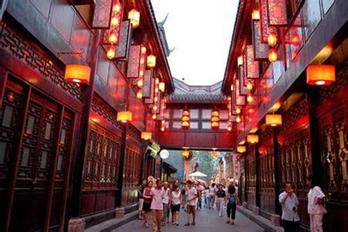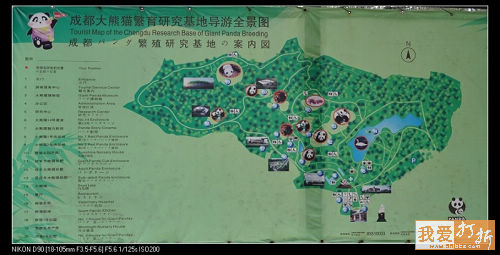◆Anjing Town
Anjing town locates in the Chengdu plain hinterland areas, eastern end of Pixian Country.
Anjing town is the hometown of the famous Shu embroidery. Before this century, nearly every woman in the town will do embroidery work, and there are dozens of large and small embroidered Squares, and its embroidery products exported to South Korea, Japan, etc.
Woman embroidered embroidery Anjing out their color depicting elegant, vivid, fine art treasures, such as the hundreds of Fish picture, hundreds of Butterflies picture and other paintings for the state win to the honor.


The exhibition hall of Shu Embroidery in Anjing town Doing Embroidery
◆Shu Embroidery
Shu embroidery, also called Chuan embroidery, is one of the most famous four embroidery styles in China. It has enjoyed high reputation as a "treasure of Sichuan" ever since the Han dynasty.


The Shu embroidery silk scarf, designed and produced by CDTC teachers
◆Jinsha Site Museum
Jinsha Site Museum locates in the sands outside Qingyang Road near the station.
Here unearthed a large palace area, general residential areas, ritual burial area and large areas such as a large number of precious cultural relics. Wealth of ancient Shu state supreme ruler of the relics found that Jinsha Sanxingdui civilization is the second after a further rise in the Chengdu plain political, economic and cultural center of the late Shang Dynasty to the Western Zhou Dynasty of ancient Shu Rhyme.

The Golden Holy Sun Bird, logo of China Cultural Heritage, founded in the Jinsha site.

The golden mask, representative excavation in Jinsha site
◆The Wide and Narrow Alley
The Wide and Narrow Alley located in the Qingyang district.
the Wide and Narrow Alley is an historic district in Chengdu, Sichuan, China, consists of three east direction between the street and the street of the House composed of inhabitants. The Wide and Narrow Alley region in the Qing dynasty for the eight banners land of living, there are many cultural, dining and leisure shops in this business.



◆Jinli Ancient Street
Jinli Ancient Street in Chengdu is very famous, where the bars and entertainment district, Sichuan food and beverage snack area, mansion inn area, tourism patchwork crafts exhibition area, known as the “Chengdu edition painting”, is the experience of the three cultural and Chengdu folk charm neighborhoods.


◆Mountain Qingcheng Scenic Area
Well-known as the most secluded place under heaven, this scenic area borders on Nt. Min, faces western Sichuan Plain, and is surrounded by groups of mountain peaks. With evergreen woods and trees, there are thousands of winding steps leading to the peak. As the birthplace of Taoism, Mt. Qingcheng is called the fifth fairyland in China, where tens of Taoist temples have been well preserved, and is a living Taoism museum with the history of thousands of years.

The Gate of Mountain Qingcheng Scenic Area


Taoist Temple and Taoist Priest
◆Dujiangyan Irrigation System
The Dujiangyan Dam, 45km rorth of Chengdu, is an ancient technological wonder of the country. More than 2000 yers ago, Li Bing(250-200BC), as a local governor of the Shu State, designed this water control and irrigation dam and organized thousands of local people to complete the project to check the Mingjiang River. For many years the river, flooded the Chengdu agricultural area and local farmers suffered a lot from the water disaster. Due to the success of the project, the dam automatically diverts the Mingjiang River and channels it into irrigation canals. For many years the dam has continued to make the most of the water conservancy works.
the wood used in the dam 

The overview of the whole system
◆Chengdu Giant Panda Breeding Research
Chengdu Giant Panda Breeding Research Base was established in 1987, is located in northern suburb of Chengdu axes Hill, 10 km away from the urban area, there is a wide road connected with the city panda, giant panda has become the launch rare and endangered wild animals such as ex situ conservation One of the main base.
Base of Giant Panda Museum was established in 1993, Giant Panda Museum, which is the only rare and endangered wild animals for the establishment of thematic museums. Has built a giant panda museum, a butterfly museum and the Museum of Vertebrate three independent but related exhibition hall, with a total area of nearly 4000 square meters. Inside the museum, on display all kinds of valuable information in Figure 800 pieces of photos, showing the main types of samples collected from Sichuan, more than 2140 kinds of physical, more than 12450 pieces; another collection of 10000 specimens, collection of thousands of types of literature books formed a human understanding of the giant panda research and protection of the theme of rescue and breeding breeding, exhibition, promotion and protection of natural biodiversity comprehensive museum.

◆Chengdu Wuhou Temple
Chengdu Wuhou Temple is one of the most popular attractions in Sichuan Province. It is the largest museum of the site left over from the Three Kingdoms Period. The temple is built to memorize Zhuge Liang, the distinguished statesman and strategies during the Three Kingdom Period, meanwhile the symbol of wisdom in Chinese people's mind. For his accomplishments as the minister and great personality, he was gain the name of Martial Marquis after his death. Hence, the temple got the name. The first building time of the temple cannot be found out now, however, it can be deducted that the time at least was as early as Tang Dynasty according to a famous Tang Poem by Du Fu. Today, the temple covers an area of 37, 000 square meters and surrounded by the red wall as well as the green pine trees.

◆Wenchuan County
May 12th is an extraordinary day in 2008, it is on this day that shocking earthquake happened in Sichuan province, China. The earthquake destroyed nearly everything in Wenchan county, Sichuan Province. Most buildings were razed in worst-hit areas with so many people, including school students, buried underneath the ruins. Roads and communication facilities have been completely destroyed, thus cut off from outside. A large number of school buildings collapsed and only a few teachers and students escaped. What was worse, days of rain has held back relief efforts. People all over the world are trying their best to help them. Thanks to the help from all over the world, the newly, beautiful buildings have been rebuilt in a very short time.






